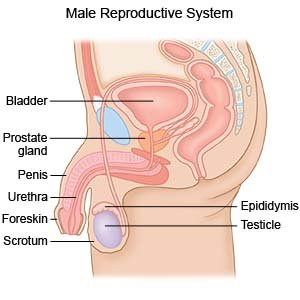Phimosis
Medically reviewed by Drugs.com. Last updated on Apr 6, 2025.
What is phimosis?
Phimosis is tight foreskin around the glans (tip) of the penis. The foreskin is so tight that it cannot be pulled back from the tip. Phimosis is most common in boys 4 years or younger.
 |
What causes phimosis?
Phimosis may happen when scar tissue forms under the foreskin after repeated infections. Skin infections are usually caused by irritation or not keeping the area clean.
What are the signs and symptoms of phimosis?
The tip may be red, swollen, or painful. Your child may have trouble urinating or have blood in his urine.
How is phimosis treated?
Your child's phimosis may get better without treatment. Your child may need medicines to decrease swelling and pain or to treat a bacterial infection. A circumcision may be done to remove your child's foreskin.
Treatment options
The following list of medications are related to or used in the treatment of this condition.
How can I manage my child's phimosis?
- Do not force the foreskin to pull back. Your child may have pain, cracking, and bleeding. A scar may form and cause the foreskin to stick to the tip of the penis.
- Keep your child's penis clean. Use gentle soap to remove smegma from around the tip. After the foreskin has separated from the tip, gently pull it back and wash this area with soap and water. Rinse the soap off. Then gently push your child's foreskin back to cover the tip of his penis. When your child is old enough, teach him how to clean the area.
- Gently move the foreskin back to the normal position. Every time the foreskin is pulled back, make sure it returns to its original position. The foreskin must always cover the tip. Do not force the foreskin away from or back over the tip. Force may cause more pain, or cause scars to form on the penis.
When should I seek immediate care?
- Your child cannot urinate.
When should I call my child's doctor?
- You are not able to move the foreskin back to the correct position.
- Your child has a fever.
- You see redness, swelling, or blisters on your child's penis.
- You see drainage from your child's foreskin.
- Your child has pain when he urinates.
- You have questions or concerns about your child's condition or care.
Care Agreement
You have the right to help plan your child's care. Learn about your child's health condition and how it may be treated. Discuss treatment options with your child's healthcare providers to decide what care you want for your child. The above information is an educational aid only. It is not intended as medical advice for individual conditions or treatments. Talk to your doctor, nurse or pharmacist before following any medical regimen to see if it is safe and effective for you.© Copyright Merative 2025 Information is for End User's use only and may not be sold, redistributed or otherwise used for commercial purposes.
Learn more about Phimosis
Treatment options
Care guides
Further information
Always consult your healthcare provider to ensure the information displayed on this page applies to your personal circumstances.
